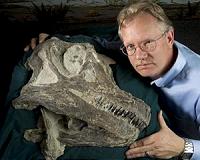| . |  |
. |
Norman OK (SPX) Feb 26, 2010 Focusing on a controversial hypothesis that ice existed at the equator some 300 million years ago during the late Paleozoic Period, two University of Oklahoma researchers originated a project in search of clues to the Earth's climate system. "The Paleozoic Period was a rare time in history," says Gerilyn Soreghan, OU professor of geology. "Broadly speaking, it was the last time our planet experienced the type of climate system we have today and in the recent past." Soreghan believes comparing more modern systems in a range of different climates might help support her hypothesis. Soreghan and Elwood Madden, assistant professor of geochemistry, want to search for answers in four distinct environments: the cold-dry environment found in Antarctica, the cold-wet environment found in Norway, the hot-wet environment found in Puerto Rico and the hot-dry environment found in the Mojave Desert. A National Science Foundation project proposal was submitted and the NSF responded with its own proposal recommending a pilot project to the most extreme location proposed-Antarctica. Soreghan was surprised and excited by the NSF proposal. She then began preparing for the journey of a lifetime. The OU team flew to New Zealand at the end of December and promptly went to the clothing distribution center to be outfitted for the trip. Even though Soreghan and two graduate students would arrive in Antarctica during the summer season, the extremely cold weather proved challenging. The trip to McMurdo Sound, Antarctica, took roughly 5 hours. Upon arrival, the team met with experienced University of Maine researcher Brenda Hall, who helped the team get ready for the next few weeks. They needed food, radios, tents and other essential equipment for the expedition. They pinpointed the glaciers where they would take water and sediment samples. When they were ready, a helicopter dropped them in the Dry Valleys and they began collecting samples in one of the smallest rivers in Wright Valley. Summer in Antarctica was colder and drier than usual and the task of collecting samples downstream was more difficult than expected. The research team would go back on another day to collect additional samples. The team moved to the Onyx River, the largest river in the valley. Sampling here was more successful as the river flows roughly six weeks during the summer. The water samples taken from the river showed non-random patterns-a good sign, according to Soreghan. The team took samples at the proximal or closest location to find out what is happening where erosion begins. Glacial systems are typically dominated by physical weathering, a process where the glacier glides across bedrock and grinds it up to create lots of surface area for water to interact with it. However, many glaciers in Antarctica are frozen to their beds, such that physical grinding is much less important than in temperate glacial systems. Chemical weathering predominates over physical weathering in warmer climates. During analyses, researchers will examine the chemistry of the sediments and water to determine if there might be certain "markers" or indicators unique to erosion in this type of climate. An electron scanning microscope will allow them to see what kind of physical erosion is going on. Glacial striations or grooves indicate grinding or patterns of grinding. Analyzing the samples will take about year, but preliminary samples taken from the Wichita Mountains in Oklahoma can be compared with the Antarctic samples to see if there are similarities.
Share This Article With Planet Earth
Related Links University of Oklahoma Explore The Early Earth at TerraDaily.com
 New Dinosaur Discovered Head First
New Dinosaur Discovered Head FirstSalt Lake City UT (SPX) Feb 26, 2010 A team of paleontologists has discovered a new dinosaur species they're calling Abydosaurus, which belongs to the group of gigantic, long-necked, long-tailed, four-legged, plant-eating dinosaurs such as Brachiosaurus. In a rare twist, they recovered four heads - two still fully intact - from a quarry in Dinosaur National Monument in eastern Utah. Complete skulls have been recovered for onl ... read more |
|
| The content herein, unless otherwise known to be public domain, are Copyright 1995-2010 - SpaceDaily. AFP and UPI Wire Stories are copyright Agence France-Presse and United Press International. ESA Portal Reports are copyright European Space Agency. All NASA sourced material is public domain. Additional copyrights may apply in whole or part to other bona fide parties. Advertising does not imply endorsement,agreement or approval of any opinions, statements or information provided by SpaceDaily on any Web page published or hosted by SpaceDaily. Privacy Statement |